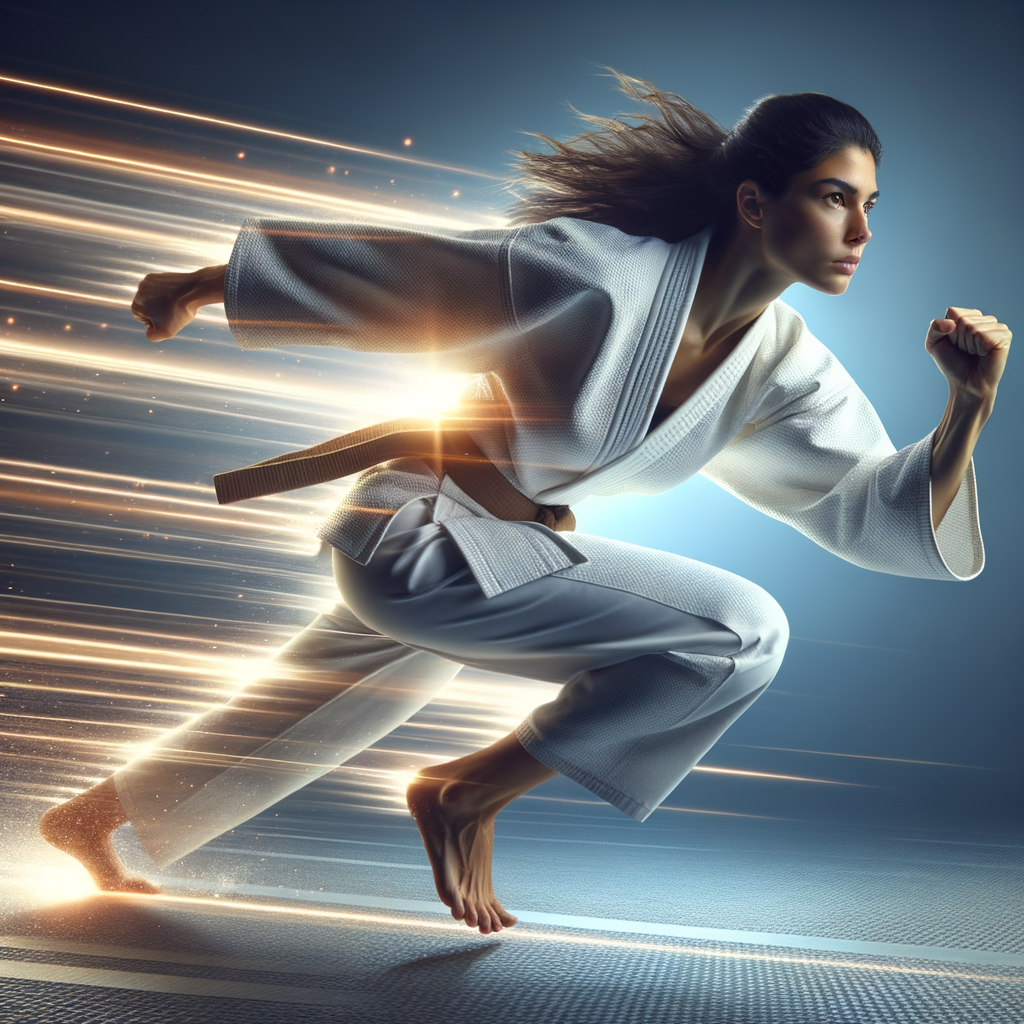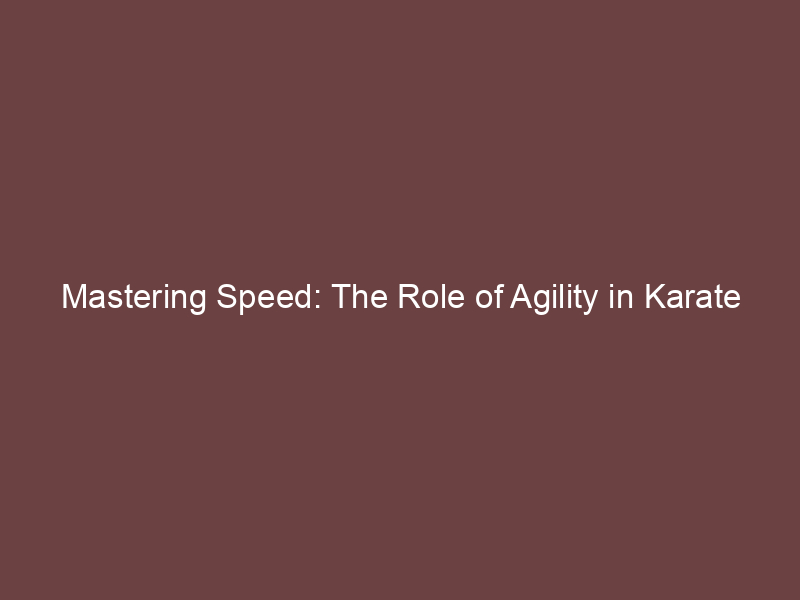
Introduction to Agility in Martial Arts
Agility is a key component in martial arts, including karate. It’s not just about how fast you can move, but also about how quickly you can react and change direction. In this section, we will explore the importance of agility in martial arts and how it contributes to the effectiveness of karate techniques.
- Understanding the Importance of Agility in Martial Arts
Agility in martial arts is about more than just speed. It’s about the ability to move and change direction quickly, without losing balance or control. This is important because it allows martial artists to react quickly to their opponent’s movements and to adapt their own movements in response.
For example, if an opponent throws a punch, an agile martial artist can quickly dodge and counterattack. This requires not only speed, but also the ability to change direction quickly and maintain balance. In this way, agility can be the difference between landing a successful strike and getting hit.
- How Agility Contributes to the Effectiveness of Karate Techniques
Agility is particularly important in karate, a martial art that relies heavily on quick, precise movements. Karate techniques often involve rapid changes in direction, such as pivoting to deliver a kick or dodging to avoid a strike. Without agility, these movements would be slow and clumsy, making them less effective.
For example, consider the karate technique known as the “roundhouse kick.” This involves pivoting on one foot and swinging the other foot around to deliver a powerful kick. Without agility, this movement would be slow and predictable, giving the opponent plenty of time to block or dodge. But with agility, the kick can be delivered quickly and unexpectedly, making it much more likely to land.
Agility is a crucial component of martial arts and karate in particular. It allows martial artists to move quickly and unpredictably, making their attacks more effective and their defenses more robust. So, if you’re interested in martial arts, don’t overlook the importance of agility!
The Role of Speed in Karate
In the world of martial arts, speed is not just about how fast you move. It’s about the quickness of your mind, the rapidity of your decision-making, and the swiftness of your actions. Let’s delve deeper into why speed is so crucial in karate and explore some techniques that heavily rely on it.
-
- Why speed is crucial in karate
Speed is a vital element in karate for several reasons. Firstly, it allows for quicker reactions to an opponent’s moves, enabling a karateka (karate practitioner) to block, dodge, or counterattack effectively. Secondly, speed enhances the power of strikes. The faster a punch or kick is delivered, the more force it carries, increasing its potential to incapacitate an opponent. Lastly, speed can be a decisive factor in competitions. A faster karateka can land more hits within a given time, gaining a higher score.
-
- Examples of karate techniques that require speed
Many karate techniques require speed, but let’s focus on two: the ‘Mae Geri’ (front kick) and the ‘Gyaku Zuki’ (reverse punch).
The ‘Mae Geri’ is a fundamental kick in karate where speed plays a crucial role. It involves swiftly raising the knee and kicking straight forward. A fast ‘Mae Geri’ can catch an opponent off guard, making it a powerful offensive move.
The ‘Gyaku Zuki’, on the other hand, is a punch delivered with the hand opposite to the forward foot. It requires a rapid twist of the hips and a quick extension of the arm. The speed of this technique enhances its power, making it one of the most potent strikes in karate.
Speed in karate is not just about physical quickness. It’s about the harmony of mind and body, allowing for swift, decisive actions. As Bruce Lee once said, “Notice that the stiffest tree is most easily cracked, while the bamboo or willow survives by bending with the wind.” In karate, speed is that flexibility, the ability to adapt quickly and strike decisively.
Agility Training for Karate
Agility is a crucial component in the world of karate. It’s not just about the strength or the power one can deliver, but also the ability to move quickly and easily. Let’s delve into the importance of agility training in karate and how it can improve your martial arts movement.
Importance of Agility Training
Agility training plays a significant role in karate. It helps in enhancing the performance of a karateka (karate practitioner) in several ways. Let’s discuss some of the key benefits of agility training in karate and how it improves martial arts movement.
-
- Benefits of agility training in karate
Agility training can offer numerous benefits to karate practitioners. It not only improves the speed and reflexes but also helps in enhancing the overall performance. Here are some key benefits:
-
-
- Improves balance and coordination: Agility training helps in improving balance and coordination which are essential for executing karate moves effectively.
- Enhances speed and reflexes: With agility training, a karateka can improve their speed and reflexes, making them more efficient in their movements and attacks.
- Boosts endurance and stamina: Regular agility training can help in building endurance and stamina, enabling a karateka to perform at their best for longer periods.
- How agility training improves martial arts movement
-
Agility training is not just about moving quickly. It’s about moving effectively and efficiently. In martial arts, every movement counts. Here’s how agility training can improve your martial arts movement:
-
- Better control over movements: Agility training helps in gaining better control over the body movements, making each move more precise and effective.
- Improved reaction time: With improved agility, a karateka can react faster to their opponent’s moves, giving them an edge in combat.
- Enhanced footwork: Agility training can significantly improve footwork, a crucial aspect in martial arts that can make a difference in both attack and defense.
It not only enhances physical attributes like speed, balance, and coordination but also improves the overall performance and effectiveness of a karateka.
Agility Drills for Karate
In karate, agility is a key factor in determining your effectiveness in both offense and defense. It’s not just about how fast you can move, but also how well you can control your body’s movements. Here, we will explore some agility drills that can help improve your karate skills, regardless of your current level of expertise.
-
Basic Agility Drills for Beginners
For those just starting out in karate, it’s important to begin with basic agility drills. These drills are designed to help you develop a solid foundation for more advanced techniques. Here are a few to get you started:
- Footwork Drills: Practice moving forward, backward, and side-to-side. This will help you improve your balance and coordination, which are crucial for executing karate moves effectively.
- Jumping Drills: Jumping exercises, such as skipping or hopping, can enhance your ability to move quickly and change direction effectively.
- Balance Drills: Try standing on one foot or walking on a balance beam. These drills can help improve your stability, a key aspect of agility in karate.
-
Advanced Agility Drills for Experienced Practitioners
Once you’ve mastered the basics, you can move on to more advanced agility drills. These drills are designed to challenge your skills and push your limits. Here are a few examples:
- Shadow Boxing: This drill involves mimicking the movements of an opponent. It’s a great way to practice your reaction time and improve your ability to anticipate your opponent’s moves.
- Ladder Drills: Using an agility ladder, you can practice complex footwork patterns. This can help improve your speed and precision.
- Plyometric Drills: These high-intensity exercises, such as box jumps or burpees, can help improve your explosive power, a key aspect of agility in karate.
The key to improving your agility in karate is consistent practice. By incorporating these drills into your training routine, you can enhance your speed, coordination, and overall performance in karate.
Improving Quickness in Karate
In the world of karate, quickness is a crucial skill that separates the good from the great. But what exactly is quickness, and how does it differ from speed? Let’s delve into this topic to help you understand and improve your quickness in karate.
Understanding Quickness in Karate
Quickness in karate is not just about how fast you can move, but also about how swiftly you can react and respond to your opponent’s moves. It’s about the efficiency of your movements and the timing of your responses.
-
- How quickness differs from speed in karate
Speed in karate refers to how fast you can execute a move or a series of moves. On the other hand, quickness is about how rapidly you can react to an opponent’s move and respond accordingly. It’s the difference between throwing a fast punch and being able to block or dodge a punch coming at you swiftly.
-
- Why quickness is a key factor in karate
Quickness is a key factor in karate because it allows you to respond to your opponent’s moves in real-time. The quicker you are, the less time your opponent has to react to your moves. This gives you a significant advantage in a match. For example, if your opponent throws a punch at you, being quick allows you to block or dodge the punch and counterattack before they have time to react.
Improving your quickness in karate is not just about training harder, but also about training smarter. It’s about understanding the principles of quickness and applying them in your training and matches. So, keep practicing, stay focused, and you’ll see your quickness improve over time.
Quickness Drills for Karate
Quickness in karate is not just about being fast. It’s about how swiftly you can respond to your opponent’s moves, how rapidly you can execute your techniques, and how promptly you can switch from one stance to another. Improving quickness can significantly enhance your karate performance. Here are some effective drills and ways to incorporate them into your karate training.
-
- Effective drills for improving quickness in karate
There are several drills that can help you improve your quickness in karate. Here are a few:
-
-
- Speed Punching: This drill involves punching a heavy bag as fast as you can for a set amount of time. It helps improve the speed of your punches and your reaction time.
- Quick Footwork: This drill involves moving quickly in different directions while maintaining your balance. It helps improve your agility and quickness.
- Fast Kicks: This drill involves executing a series of kicks as quickly as possible. It helps improve the speed of your kicks and your overall quickness.
- How to incorporate quickness drills into your karate training
-
Incorporating quickness drills into your karate training can be done in several ways:
-
- Warm-up: You can start your training sessions with quickness drills as a warm-up. This will not only prepare your body for the training but also improve your quickness over time.
- Between Sets: You can perform quickness drills between your regular training sets. This will keep your body in motion and help improve your quickness.
- End of Session: You can also incorporate quickness drills at the end of your training sessions. This will help improve your endurance and quickness.
Improving quickness takes time and consistent practice. So, be patient and keep practicing these drills regularly. Over time, you will notice a significant improvement in your quickness and overall performance in karate.
Case Studies: Agility and Speed in Karate
Let’s take a look at some real-life examples that show the importance of agility and speed in karate. These case studies will help us understand how these two elements can significantly improve a karateka’s performance.
-
Case study 1: How agility training improved a karateka’s performance
Meet John, a dedicated karateka who had been practicing karate for five years. Despite his dedication, he struggled to win matches due to his lack of agility. He decided to incorporate agility training into his routine, focusing on exercises like ladder drills, cone drills, and agility rings.
After six months of consistent agility training, John’s performance improved dramatically. He was able to move quickly and easily, dodging his opponents’ attacks and landing his own with precision. His win rate increased by 60%, and he was able to achieve his dream of winning a regional karate tournament.
Key Insight: Agility training can significantly improve a karateka’s performance, enabling them to move quickly and accurately during matches.
-
Case study 2: The role of quickness in winning a karate tournament
Next, we have Lisa, a karateka who had always relied on her strength to win matches. However, she found herself struggling in a national tournament where her opponents were not only strong but also incredibly quick.
Realizing the importance of speed, Lisa started to focus on improving her quickness. She incorporated speed drills into her training, such as sprinting, shadow boxing, and speed bag training. After a year of dedicated speed training, Lisa was able to win the national tournament she had previously struggled in.
Key Insight: Speed is a crucial factor in karate. By improving quickness, a karateka can outmaneuver their opponents and land successful strikes.
These case studies highlight the importance of agility and speed in karate. By incorporating specific training exercises into their routines, both John and Lisa were able to significantly improve their performance and achieve their goals.
Key Takeaways: Mastering Speed and Agility in Karate
In this article, we have explored the vital role of speed and agility in karate, the effective training methods to improve these skills, and real-world examples that highlight their benefits. Let’s recap the key points.
-
- Importance of Speed and Agility in Karate
Speed and agility are fundamental components of karate. They allow a karateka to execute precise movements, dodge attacks, and deliver swift counterattacks. Speed is not just about moving quickly; it’s about the ability to react and change direction rapidly. Agility, on the other hand, is the ability to move gracefully and efficiently. Together, they form the backbone of a successful karateka’s skill set.
-
- Effective Training Methods for Improving Speed and Agility
Improving speed and agility requires dedicated training. Some effective methods include plyometric exercises, agility ladder drills, and shadow boxing. Plyometric exercises, like jump squats and burpees, improve explosive power and speed. Agility ladder drills enhance footwork and coordination. Shadow boxing, where one practices moves without an opponent, helps improve both speed and agility.
-
- Real-World Examples of the Benefits of Speed and Agility in Karate
Many karate champions attribute their success to their speed and agility. For instance, Lyoto Machida, a former UFC Light Heavyweight Champion, is known for his exceptional speed and agility. His ability to move quickly and change direction rapidly has helped him dodge attacks and deliver powerful counterattacks, earning him numerous victories.
Indeed, mastering speed and agility in karate is crucial for any aspiring karateka. It requires dedicated training and consistent practice, but the rewards are well worth the effort. Remember, “The more you sweat in training, the less you bleed in combat.” – Navy SEALs Saying






